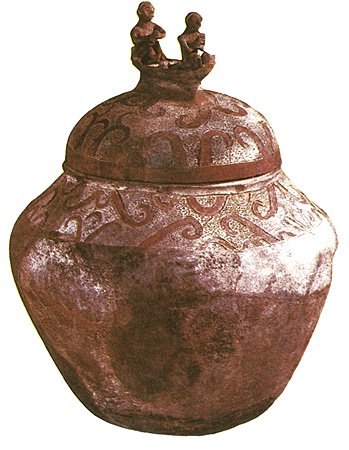Cultural Center of the Philippines
ENCYCLOPEDIA OF
PHILIPPINE ART
[Manunggul Jar]
890 to 710 BC / 66.5 x 51.5 cm / Earthenware / National Museum of the Philippines collection
The Manunggul jar from Palawan was used about 2,700 years ago to protect the remains of the dead. It is valued as the most impressive work of ancient pottery in the Philippines. It was discovered in the Manunggul Cave, Lipuun Point.
The jar has a beautifully sculpted lid, unlike other burial jars that have simple handles on their rounded covers. This lid features a pair of small, three-dimensional figures on a boat. The figures represent the souls of the dead rowing their way to the afterlife. The first one has his arms crossed over his chest, while the second holds a paddle in his hands. Both have neatly proportioned limbs and doll-like facial features. Although executed in primitive style, the soul figures are of rare sculptural quality for the period. Their boat to the other world is also crafted in detail. It has a human face carved on its prow.
While the figurative sculpture on the lid is the jar’s center of interest, even the body of the jar invites attention. Graceful curvilinear designs fill its upper section. These designs were painted in red hematite (the primary mineral ore of iron) for emphasis and to provide variation from the jar’s predominantly brown hue. As red was considered a sacred color by the tribal group from which the jar comes, it was used by its potters on special burial vessels.
The Manunggul jar stands as sociological evidence of a society with clear beliefs in both the existence of the soul and life after death, thousands of years before contact with organized religions. It also reveals the high level of artistic skills possessed by its neolithic makers, for only a master potter could have created a jar of such original and striking beauty.
Written by Alice G. Guillermo
